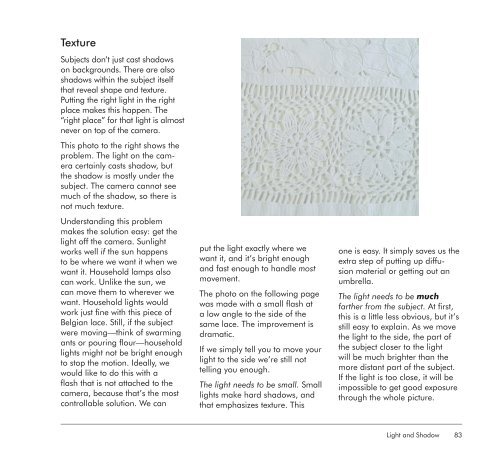Focus On Lighting Photos Focus on the Fundamentals.pdf
You also want an ePaper? Increase the reach of your titles
YUMPU automatically turns print PDFs into web optimized ePapers that Google loves.
Texture<br />
Subjects d<strong>on</strong>’t just cast shadows<br />
<strong>on</strong> backgrounds. There are also<br />
shadows within <strong>the</strong> subject itself<br />
that reveal shape and texture.<br />
Putting <strong>the</strong> right light in <strong>the</strong> right<br />
place makes this happen. The<br />
“right place” for that light is almost<br />
never <strong>on</strong> top of <strong>the</strong> camera.<br />
This photo to <strong>the</strong> right shows <strong>the</strong><br />
problem. The light <strong>on</strong> <strong>the</strong> camera<br />
certainly casts shadow, but<br />
<strong>the</strong> shadow is mostly under <strong>the</strong><br />
subject. The camera cannot see<br />
much of <strong>the</strong> shadow, so <strong>the</strong>re is<br />
not much texture.<br />
Understanding this problem<br />
makes <strong>the</strong> soluti<strong>on</strong> easy: get <strong>the</strong><br />
light off <strong>the</strong> camera. Sunlight<br />
works well if <strong>the</strong> sun happens<br />
to be where we want it when we<br />
want it. Household lamps also<br />
can work. Unlike <strong>the</strong> sun, we<br />
can move <strong>the</strong>m to wherever we<br />
want. Household lights would<br />
work just fine with this piece of<br />
Belgian lace. Still, if <strong>the</strong> subject<br />
were moving—think of swarming<br />
ants or pouring flour— household<br />
lights might not be bright enough<br />
to stop <strong>the</strong> moti<strong>on</strong>. Ideally, we<br />
would like to do this with a<br />
flash that is not attached to <strong>the</strong><br />
camera, because that’s <strong>the</strong> most<br />
c<strong>on</strong>trollable soluti<strong>on</strong>. We can<br />
put <strong>the</strong> light exactly where we<br />
want it, and it’s bright enough<br />
and fast enough to handle most<br />
movement.<br />
The photo <strong>on</strong> <strong>the</strong> following page<br />
was made with a small flash at<br />
a low angle to <strong>the</strong> side of <strong>the</strong><br />
same lace. The improvement is<br />
dramatic.<br />
If we simply tell you to move your<br />
light to <strong>the</strong> side we’re still not<br />
telling you enough.<br />
The light needs to be small. Small<br />
lights make hard shadows, and<br />
that emphasizes texture. This<br />
<strong>on</strong>e is easy. It simply saves us <strong>the</strong><br />
extra step of putting up diffusi<strong>on</strong><br />
material or getting out an<br />
umbrella.<br />
The light needs to be much<br />
far<strong>the</strong>r from <strong>the</strong> subject. At first,<br />
this is a little less obvious, but it’s<br />
still easy to explain. As we move<br />
<strong>the</strong> light to <strong>the</strong> side, <strong>the</strong> part of<br />
<strong>the</strong> subject closer to <strong>the</strong> light<br />
will be much brighter than <strong>the</strong><br />
more distant part of <strong>the</strong> subject.<br />
If <strong>the</strong> light is too close, it will be<br />
impossible to get good exposure<br />
through <strong>the</strong> whole picture.<br />
Light and Shadow<br />
83



